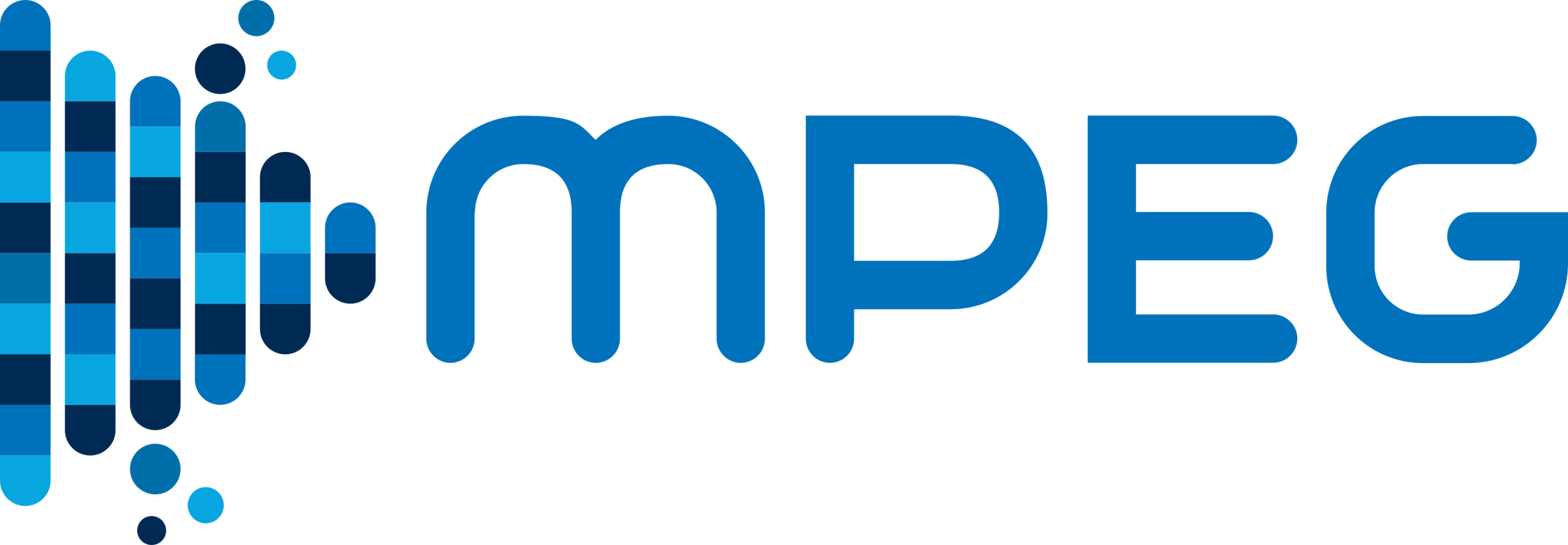Standards
The following well-known MPEG standards give a short overview of the impressive and industry-wide established media standards MPEG is know for:
Video coding: MPEG-1, MPEG-2, AVC, HEVC, LCEVC, VVC
Audio coding: MP3, AAC, USAC, 3D Audio
Distribution: MPEG-2 Systems, MP4 file format, MPEG-DASH, MMT
The following list gives a full overview over all standards developed by MPEG:
MPEG-I (ISO/IEC 23090)
A collection of standards to digitally represent immersive media
MPEG-DASH (ISO/IEC 23009)
DASH is a suite of standards providing a solution for the efficient and easy streaming of multimedia using existing available HTTP infrastructure (particularly servers and CDNs, but also proxies, caches, etc.).
MPEG-H (ISO/IEC 23008)
Suite of standards for heterogeneous environment delivery of audio-visual information compressed with high efficiency
MPEG-G (ISO/IEC 23092)
A suite of standards to provide new effective and interoperable solutions for genomic information processing applications
MPEG-4 (ISO/IEC 14496)
A suite of standards for multimedia for the fixed and mobile web.
MPEG-5 (ISO/IEC 23094)
Standard to collect video coding parts
MPEG-2 (ISO/IEC 13818)
A suite for standards for digital television
MPEG-1 (ISO/IEC 11172)
A suite of standards for audio-video and systems particularly designed for digital storage media
MPEG-IoMT (ISO/IEC 23093)
APIs for communicating media devices (called Media Things)
MPEG-CICP (ISO/IEC 23091)
A suite of standards to specify code points for non-standard specific media formats
MPEG-U (ISO/IEC 23007)
Specification of the exchange, the display, the control and the communication of widgets with other entities and for data format for advanced user interaction (AUI) interfaces to support various advanced user interaction devices.. MPEG-U provides a general purpose technology with innovative functionality that enable its use in heterogeneous scenarios such as broadcast, mobile, home network and web domains
MPEG-M (ISO/IEC 23006)
MPEG-M is a suite of standards to enable the easy design and implementation of media-handling value chains whose devices interoperate because they are all based on the same set of technologies, especially MPEG technologies accessible from the middleware and multimedia services
MPEG-V (ISO/IEC 23005)
MPEG-V outlines an architecture and specifies associated information representations to enable interoperability between virtual worlds (e.g., digital content provider of a virtual world, gaming, simulation), and between real and virtual worlds( e.g., sensors, actuators, vision and rendering, robotics). Please see http://wg11.sc29.org/mpeg-v/ for a detailed spacification.
MPEG-E (ISO/IEC 23004)
A standard for an Application Programming Interface (API) of Multimedia Middleware (M3W) that can be used to provide a uniform view to an interoperable multimedia middleware platform.
MPEG-C (ISO/IEC 23002)
A suite of video standards that do not fall in other well-established MPEGVideo standards
MPEG-B (ISO/IEC 23001)
A suite of standards for systems technologies that do not fall in other well-established MPEG standards
MPEG-A (ISO/IEC 23000)
A suite of standards specifying application formats that involve multiple MPEG and, where required, non MPEG standards
MPEG-21 (ISO/IEC 21000)
A suite of standard that define a normative open framework for end-to-end multimedia creation, delivery and consumption that provides content creators, producers, distributors and service providers with equal opportunities in the MPEG-21 enabled open market, and also be to the benefit of the content consumers providing them access to a large variety of content in an interoperable manner.
MPEG-MAR (ISO/IEC 18039 )
A Mixed and Augmented Reality Reference Model developed jointly with SC 24/WG 9
MPEG-7 (ISO/IEC 15938)
A suite of standards for description and search of audio, visual and multimedia content
MPEG-D (ISO/IEC 23003)
A suite of standards for Audio technologies that do not fall in other MPEG standards
